Unleashing Speed: A Closer Look at 2022’s Formula 1 Cars
The roar of engines, the thrill of competition, and the relentless pursuit of speed—Formula 1 has long captured the imagination of motorsport enthusiasts around the globe. As teams took to the tracks in 2022, a new generation of cars emerged, meticulously engineered to push the boundaries of performance and innovation. This season brought with it not only stunning designs and cutting-edge technology but also a number of regulatory changes aimed at enhancing both safety and competition. From aerodynamic advancements to power unit developments, the 2022 Formula 1 cars are a testament to the relentless ingenuity of their creators. Join us as we explore the key features, technological advancements, and the overall impact of these remarkable machines on the sport we love.
Table of Contents
- Evolution of Aerodynamics in 2022 Formula 1 Cars
- Powertrain Innovations and Their Impact on Performance
- Tire Technology Advances and Race Strategy Optimization
- Sustainability Initiatives in Formula 1 Design for 2022
- Q&A
- Concluding Remarks
Evolution of Aerodynamics in 2022 Formula 1 Cars
The 2022 Formula 1 season ushered in a new era of aerodynamics, driven by regulations aimed at enhancing overtaking and competition. Teams had to redesign their cars fundamentally, with a keen focus on ground effect aerodynamics. This allowed for greater downforce at lower speeds, transforming how cars handle through corners. Key innovations included:
- Venturi Effect: A focus on creating a powerful ground effect through sculpted underbodies.
- Rear Wing Designs: Updated aerodynamics that optimized airflow and reduced drag.
- Wider Tires: Improved grip contributing to more aggressive cornering capabilities.
Additionally, the use of adjustable aerodynamic elements became a focal point, enabling teams to fine-tune performance based on circuit conditions. The challenges of balancing downforce with speed led to some creative solutions, including:
- Sidepod Configurations: Unique designs to channel airflow efficiently while cooling the power unit.
- Diffuser Optimization: Enhanced designs that increased the effectiveness of ground effect.
- Drag Reduction Systems: Modifications that allowed for strategic advantages during race situations.
| Feature | Impact on Performance |
|---|---|
| Ground Effect | Improved cornering stability and speed |
| Wider Tires | Enhanced grip during acceleration |
| Adjustable Aerodynamics | Increased adaptability to race conditions |
Powertrain Innovations and Their Impact on Performance
The 2022 season saw Formula 1 cars undergoing significant enhancements in their powertrain technologies, embracing a fusion of hybrid efficiency and performance optimization. Teams focused on maximizing energy recovery systems, which play a crucial role in harnessing wasted energy and converting it into useable power. To achieve this, the latest generation of turbocharged engines, combined with advanced electrical systems, enabled drivers to unleash astonishing torque at critical moments, especially during race starts and overtaking maneuvers. Some key innovations included:
- Improved Energy Recovery: Enhanced ERS capabilities allowed for more effective harvesting and deployment of energy.
- Turbocharger Advancements: Newer designs reduced lag, providing instantaneous throttle response.
- Lightweight Materials: The integration of lightweight composites in engine parts minimized weight while maintaining strength.
These innovations not only contributed to faster lap times but also pushed teams to rethink their strategies, balancing fuel efficiency with raw speed. The introduction of the next-generation power units sparked a rivalry among manufacturers, with horsepower figures climbing to exhilarating heights. A comparative look at 2022 powertrain specifications reveals the trend towards a holistic approach to performance:
| Team | Power Output (HP) | Weight (Kg) | Hybrid Efficiency (%) |
|---|---|---|---|
| Mercedes | 1000+ | 150 | 40 |
| Ferrari | 1000+ | 145 | 42 |
| Red Bull | 1000+ | 148 | 39 |
Tire Technology Advances and Race Strategy Optimization
Recent advancements in tire technology have revolutionized how teams approach race strategies in Formula 1. With innovations like adaptive rubber compounds, teams can now tailor their tire choices based on real-time data and specific track conditions. The ability to switch between soft, medium, and hard compounds during a race has heightened the tactical aspect of Formula 1, allowing teams to maximize performance while minimizing degradation. This iterative approach aligns tire performance with the evolving conditions on the circuit, enhancing grip and reducing lap times, leading to thrilling on-track battles.
Moreover, data analytics plays a crucial role in race strategy optimization. By utilizing advanced telemetry, teams can monitor tire wear and performance metrics with unparalleled accuracy. This results in strategic decision-making that can pivot during the race, influenced by variables such as weather changes, track temperature, and competitor behavior. For instance, a typical race strategy might involve:
| Tire Compound | Optimal Usage Conditions | Expected Lifespan |
|---|---|---|
| Soft | Ideal for qualifying and early race | 10-15 laps |
| Medium | Versatile option for dry conditions | 15-25 laps |
| Hard | Best in long stints or adverse weather | 25-40 laps |
This integration of tire technology and race strategy marks a new era in Formula 1, where teams must stay agile and informed to secure their competitive edge on the track.
Sustainability Initiatives in Formula 1 Design for 2022
In an era where environmental consciousness is at the forefront of global discourse, Formula 1 has adopted innovative strategies to integrate sustainability into its design for 2022. One key initiative is the shift towards 100% sustainable fuels. This revolutionary approach enables teams to enhance performance while minimizing carbon footprints. Additionally, the lightweight materials developed for car structure not only improve agility on the track but also reduce overall resource consumption.
- Hybrid Power Units: Improved efficiency in energy recovery systems.
- Recyclable Components: Increased use of recyclable materials in car construction.
- Carbon Neutral Targets: Ambitious plans for net-zero carbon emissions by 2030.
Moreover, teams are exploring ways to optimize their logistics and operations, maximizing efficiency throughout the supply chain. This includes minimizing travel emissions through a strategic overhaul of transport methods and facilities. By employing various technologies, Formula 1 aims to create an engaging yet responsible spectator experience, highlighting the importance of environmental stewardship within the sport.
| Initiative | Impact |
|---|---|
| Sustainable Fuels | Reduces carbon emissions during races |
| Lightweight Materials | Enhances performance with lower resource use |
| Carbon Neutral Goals | Sets a benchmark for future racing |
Q&A
Q&A: Exploring Formula 1 Cars of 2022
Q1: What were the major design changes for Formula 1 cars in 2022?
A1: The 2022 Formula 1 season marked a significant shift in car design, primarily influenced by revised regulations aimed at improving racing dynamics. One key change was the introduction of ground effect aerodynamics, which focused on enhancing downforce by creating a venturi effect under the car. Teams also adopted wider tires and redefined front and rear wings, allowing for better grip and improved handling. These changes aimed to reduce dirty air and make overtaking easier, adding excitement to the races.
Q2: How did the new regulations impact team performance?
A2: The new regulations brought about a more level playing field, as teams had to adapt to the updated aerodynamic principles. While historically dominant teams like Mercedes faced challenges due to their previous designs, others like Ferrari and Red Bull Racing leveraged the new rules to their advantage. This led to an unpredictable season where rivalries intensified, allowing fans to witness closer races and emerging talents showcase their skills.
Q3: Which teams stood out in the 2022 season and why?
A3: In 2022, Red Bull Racing emerged as a powerhouse, with Max Verstappen securing the championship in a dominant fashion. Their innovative design and strong integration of the new aero regulations set them apart. Ferrari also returned to competitive form, placing significant emphasis on their engine performance and reliability. Other teams, such as Mercedes, initially struggled but displayed resilience by making substantial improvements as the season progressed.
Q4: How did technology advancements influence the 2022 cars?
A4: Technology played a pivotal role in shaping the 2022 Formula 1 cars. Teams integrated advanced materials for weight reduction, employed sophisticated simulations for design optimization, and enhanced telemetry systems for real-time data analysis. These innovations contributed to finer-tuned performance and strategic decision-making during races, pushing the boundaries of engineering and technology in motorsports.
Q5: What role did sustainability play in the development of the 2022 cars?
A5: Sustainability became increasingly important in 2022, with Formula 1 maintaining its commitment to reducing the sport’s ecological footprint. All teams used fuel comprising 10% renewable content, and discussions surrounding hybrid power units continued to evolve. The aim was to showcase their commitment to innovation in sustainability while enhancing performance, thereby inspiring both fans and manufacturers toward greener solutions.
Q6: What can fans look forward to in the future of Formula 1 car designs?
A6: As we look ahead, the future of Formula 1 car designs is promising and continues to evolve. The ongoing push for sustainability will likely see further incorporation of hybrid technologies and renewable fuels. Additionally, as new regulations are rolled out, teams will continue to experiment with innovative aerodynamic concepts and lightweight materials. Fans can expect increasingly competitive racing, thrilling technology showcases, and the potential for even more surprising outcomes in championships to come.
—
Feel free to ask any further questions about the intriguing world of Formula 1!
Concluding Remarks
As we conclude our journey through the thrilling world of Formula 1 cars in 2022, it becomes clear that this season has marked a pivotal moment in the sport’s evolution. The innovative designs and cutting-edge technology have not only reshaped the aesthetics of the cars but have also transformed the very dynamics of racing. Each team, driven by the relentless pursuit of speed and efficiency, has contributed to a tapestry of competition that captivates fans around the globe.
The advancements we’ve witnessed this year will undoubtedly lay the groundwork for future seasons, pushing the boundaries of engineering and performance even further. As we look ahead, the excitement builds for what is yet to come, reminding us that the essence of Formula 1 lies not just in its cars, but in the spirit of competition and the unyielding drive for excellence.
Whether you’re a die-hard fan or a casual observer, the 2022 Formula 1 season has been a testament to the power of innovation. With every race, we’ve seen the exhilarating dance of man and machine, an ongoing saga that keeps us on the edge of our seats. So, as we bid farewell to this season, let’s celebrate the legacy of the cars that pushed the limits of possibility and eagerly await the next chapter in the illustrious history of Formula 1.



